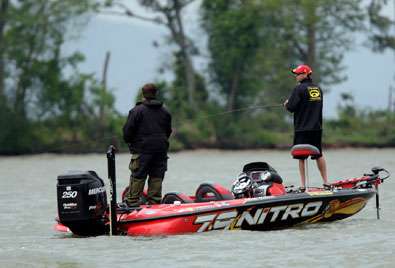
Most fishermen think they have to slow down and fish finesse lures to coax bass into biting during the postspawn period. I can't fish that way. I still employ my fast moving, power fishing techniques, but in a slightly modified fashion.
Remember, not every fish in the lake spawns at the same time. The spawn can cover several months, so there are always some aggressive bass around. Once you identify a spawning area and the bass are off the beds, concentrate your efforts in that area because bass tend to hang around for a couple of weeks. The bigger females tend to hang out and rest nearby. They love to suspend under cover like matted grass, boat docks, bushes, standing timber or around a laying log.The key to getting them to bite is to use erratic presentations and lures that stay in the strike zone longer.
Some of my favorites are jerkbaits and soft plastic jerkbaits like Strike King's Caffeine Shad. Those are good baits that have a lot of lively action, and you can keep them in a small area for a longer period.Topwaters work, too. Baits like the Sammy, Zara Spook, and Strike King's Spittin' King walk side-to-side, have a lot of action and make a lot of commotion.
Another key to remember about the postspawn period is that shad and bluegills are starting to spawn about then. The bass definitely like to feed on those smaller fish when they're bedding, so you need to keep an eye out for that kind of activity. Here are some power fishing tips for those:
Shad spawn shallow on rocky or clay points during low light periods. Postspawn bass know that and get active there when the shad spawn is on. You can get some great feeding action for the first hour in the morning or the last hour in the evening when this pattern is working. On lakes with deeper grasslines, or if the water is colored, the shad will stay in the shallows a little longer. The bass will get tight to areas where they can ambush the shad against the docks, rocks or right up in the dirt. The Spittin' King or a small spinnerbait are good choices for this pattern, but you've got to keep the lure in the strike zone for as long as possible and cover a lot of water. The fish will tell you where they are.
One of the best ways to find spawning shad is to throw a willowleaf spinnerbait. The shad will literally get right in with its blades, trying to spawn with the lure. You may feel them bumping the bait or see them swimming behind it, and the bass will come racing in to crush them.
Bass are there to feed, but sometimes it takes a little effort to trick them. You can't cast a spinnerbait and reel it in. I'm going to shake it, jerk it and twitch it to make it look like an injured shad.
If the water is clear, I use natural looking shad imitators in translucent or natural shad patterns for topwaters and jerkbaits and Sexy Shad for my spinnerbaits.
Bluegills tend to spawn better in the middle of the day, so that's when you find bass around those bedding areas. They usually spawn in secondary pockets or on little secondary points — places that are protected from big waves and wind. If the water is clear — and with the help of polarized sunglasses — they'll show up as little, dished-out areas.
Bass patrol the edges of those bluegill bedding areas. They are ambushing the spawning bluegills or other bluegills that are there cannibalizing the eggs, or even crawfish that have crawled into the bed for a feast. When fishing around spawning forage during the bass' postspawn, I throw the same reaction baits as I do during the shad spawn but will include a few finesse baits, too. I like to use a tube, a Carolina-rigged straight-tail worm or shaky head worm because they move erratically when you pull them through the water, yet I can still keep them in the strike zone for a little longer period of time. However, I don't take two minutes or more to "finesse" them back to the boat. I'm going to work my finesse lures quickly and erratically in the targeted area.
Colors? Bluegill-type, of course. I prefer watermelon or green pumpkin soft plastics and like to add a little chartreuse coloring on the tail. I may even add a dab of blue dye on them, to make them look more like a bluegill.
Be efficient. I always strive to maximize my time and remain efficient, especially during the shad spawn when the daytime window of opportunity is so short. I cover as much of the right kind of water as possible.
If I know shad are spawning on docks or riprap, I fish as many as I can in that short window. Although I'm trying to keep the bait in the strike zone longer, I'm still covering water quickly in high potential areas.
That's why boat position is critical. If I'm fishing riprap, I'll fish parallel to the rocks so the lure never leaves the strike zone. If fishing docks, I'm going to zip a lure down one side, shaking and jerking it all the way to the boat, then dart around to the other side and repeat the action before running my electric motor on high to get to the next dock. Ditto for fishing bluegill beds. I run from bedding area to bedding area, working my lures quickly and erratically. I'll make quick presentations with different lures and then move on to the next spot.
The postspawn period can be a slow fishing period, but it's very much a run-and-gun time of the year for me.
That's just how I roll.
Originally published May 2009





